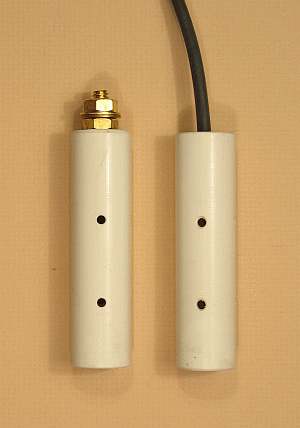Seawater Reference Electrode Model IP
The Seawater Reference Electrode, Model IP, is a compact, economical, dry-type reference electrode for marine applications. It is 0.840 inch (21.3 cm) diameter which enables the user to cement on any 1/2 inch socket-end PVC pipe or electrical conduit fitting (e.g. male or female conduit thread or couplings) for permanent installation. Examples of this are shown on EDI Drawing IPASY – 5 in our data sheet where 1/2 inch PVC couplings serve as transition pieces for running the lead wire through conduit or attaching the electrode to a wall. For intermittent use, the Model IP has a blind 1/4–20 NC tapped hole for attaching up to a 5 lb (2 kg) weight. Should more weight than that be necessary, the electrode and the weight should be attached to a separate drop line as shown on EDI Drawing IPASY – 4. The electrode may be ordered with either a 1/4 – 20-NC stud end or #18AWG test lead wire. An optional copper sleeve is available which prevents excessive biofouling during extended exposures in seawater.

Model IP is intended for use in clean full strength seawater. Our Model IR-AGG Immersion Reference will give better service in polluted seawater or brackish seawater where the salinity varies with the tidal cycle.
Element Selection Guide
EDI reference electrodes may be ordered with any of five different reference elements. The element selected depends upon the electrolyte in which the electrode is used.
Gelled copper/copper sulfate elements (EDI code CUG) are typically used in environments with less than 500 ppm chloride or other halides. They consist of high purity metallic copper immersed in a saturated CuSO4 solution containing a gelling agent. Use of these elements in electrolytes with higher halide levels or in electrolytes with any sulfides present will contaminate the element causing its reference potential to drift. Because of their widespread use, Cu/CuSO4 electrodes are the ones upon which many cathodic protection criteria are based. Cu/CuSO4 elements are available in all EDI product groups except Concrete Products.
Gelled silver/silver chloride elements (EDI code AGG) can be used in any environment which does not contain sulfides. They consist of 99.99% pure silver coated with silver chloride and immersed in a saturated potassium chloride solution containing a gelling agent. The reference potential of Ag/AgCl/sat. KCl elements is 105 mV negative to that of a saturated Cu/CuSO4 reference electrode. Ag/AgCl/sat. KCl elements are available in all EDI product groups.
Dry silver/silver chloride elements (EDI code AGD) are most commonly used in clean full strength seawater where the electrolyte comes into direct contact with the element. Like the gelled Ag/AgCl elements, they are adversely affected by sulfides. The reference potential of dry Ag/AgCl elements immersed in full strength seawater is 70 mV negative to that of a saturated Cu/CuSO4 reference electrode. As the ambient chloride level decreases, as would be the case when used in brackish water, the reference potential becomes less positive. Dry Ag/AgCl elements are only available in our through-wall, immersion and tubesheet mounted reference electrodes.
Dry silver/silver chloride elements for concrete (EDI code AGC) is a variation of our standard dry Ag/AgCl element which has been adapted for encasement in a cement-based grout. The reference potential depends on the pore water chloride level of the concrete structure in which it is embedded. This element is only available in our Marine Concrete reference electrode, EDI Model CM-AGC.
Zinc elements (EDI code ZIN) consist of high purity metallic zinc rod. When these elements are used in our underground reference electrodes, the zinc element is encased in a gypsum-bentonite backfill. The zinc element is directly wetted by the electrolyte in our through-wall and immersion reference groups. Reference potential of a zinc element encapsulated in backfill is about 1,100 mV negative to that of a saturated Cu/CuSO4 reference electrode. The reference potential of zinc directly exposed to an electrolyte depends on the composition of the electrolyte.
Design Life
The design life of a reference electrode is an estimate of the time based on test results it would take for enough salt to diffuse out from the inner core to lower the salt concentration to below saturation. At EDI, we use several techniques to extend this time as much as possible. One of these techniques is to increase the amount of salt reserve contained in the gel. This is one reason why longer life electrodes have physically bigger housings. Download our paper Factors Affecting the Accuracy of Reference Electrodes to learn more.
For More Information
Complete Product Information is available for downloading as pdf files. Click on the link below to download.
Seawater Reference Electrode (Model IP) data sheet.
EDI products may be purchased from any corrosion control products distributor or directly from EDI.
